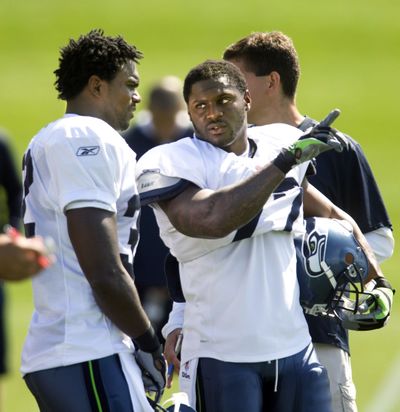Seahawks RB OK with new role
James content to back up Jones

RENTON, Wash. – Running back Edgerrin James wore No. 32 for his first practice as a Seahawk, the same jersey number he had first in Indianapolis and for the past three years in Arizona.
It’s his role on the Seahawks that is new.
The NFL’s active leader in career rushing yards is a component of Seattle’s backfield, not the centerpiece. He’s a side dish, while starter Julius Jones is the entree.
“I’m not here to compete with Julius,” James said after practice. “I’m here to complement him.”
James is one part of the equation, and the latest backfield addition Seattle has culled from the free-agent ranks. At a position known for players with track speed, the Seahawks have opted to go with players who have a track record over the past few years.
James is the third veteran running back Seattle has signed over the past 18 months while they’ve drafted just one tailback in the five drafts since Tim Ruskell became the team’s president. That was Justin Forsett, a seventh-round pick in 2008 who is now the team’s third-string tailback.
Is there a risk relying so heavily upon free agents to restock the running game?
“It can be the same in the draft,” coach Jim Mora said. “They’re both, at times, it’s speculation. You’re predicting what someone’s going to do.”
The Seahawks have chosen three fullbacks in the last five drafts, but just one tailback, fewest in the league. Minnesota and Washington are tied for second-fewest, each having picked two running backs from 2005-2009.
Seattle never decided to go young after its ground game got old following the decision to re-sign Shaun Alexander in 2006. Tough to blame anyone for that decision since Alexander was the reigning NFL MVP, and the Seahawks were coming off a Super Bowl appearance.
The contract was officially for seven years, but the reality was Seattle needed just three good seasons to make it worthwhile. It got one year in which Alexander was injured, and a second season in which he was tentative, slow and never gained more than 100 yards in the final three months of the season.
Seattle’s ground game eroded from No. 3 in the league in 2005 to No. 14 in 2006 to No. 20 in 2007 and No. 19 in 2008. Alexander was released last year after the Seahawks decided to improve the backfield in free agency by signing Jones and T.J. Duckett. Seattle paid Duckett more than $4 million for what amounted to one year’s worth of heavy-lifting as he was Seattle’s short-yardage back.
Duckett was supposed to be Seattle’s closer this year, the big man who would come in for short-yardage situations and to control the ball late in the fourth quarter, leaning on a defense with every ounce of his 254-pound frame. The Seahawks decided that Duckett had become more of a short-game specialist and they needed someone more versatile.
“In order to run the ball the way we want to run the ball, we needed someone that could complement Julius,” Mora said.
Maurice Morris was gone, having signed with Detroit in the offseason, which left Seattle searching through the list of available veterans to find someone capable of handling every-down responsibilities should Jones go down.
James has a history that shows he can do that. Seattle signed him to a one-year contract with the hope that he has a future in that capacity, too, as the latest veteran the Seahawks have turned to in hopes of jump-starting the ground game.